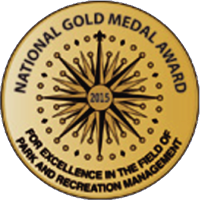- CRC
Age-Based Interests
- Program Guide
- Programs
Age-Based Interests
- Schedules
- Register
Registration Information
- CRC
Age-Based Interests
- Program Guide
- Programs
Age-Based Interests
- Schedules
- Register
Registration Information
PERFORMANCE
The Park District has invested over $68 million in improvements of its parks, facilities, and equipment since the passing of the 2005 “Renew Our Parks” referendum. It is vital that the Park District incorporate preventative and sustainable operational measures in order to maintain these investments The following charts measure the current quality of the Park District’s parks and maintenance as well as how consistently the Park District is following through with planned on-going improvements and upkeep to its parks and facilities.
The Park System Grade is the average score, on a scale of 0 to 100, from the Park District’s Park Report Card tool indicating the quality and maintenance of the park system. This measure does not include Park District buildings (except for public restrooms), pools, or dog parks.
*Data for this chart is updated annually in October from results from the Park District’s Park Report Card
Park District Park Report Cards:
2020 Parks Report Card
2019 Parks Report Card
2018 Parks Repot Card
2017 Park Report Card
2016 Park Report Card
2015 Park Report Card
2014 Park Report Card
Who are the stakeholders impacted?
Park patrons and staff
What does the data say?
In 2019, the Park District scored a record-high with a (92). The highest scores were Ridgeland Common, Cheney Mansion, Randolph Park, and Euclid Square.
What is causing the data trend?
The lowest scores were at Barrie Park (worn playground), Longfellow Park (worn playground), and Wenonah Park (migrated sand).
What outcome are we trying to achieve?
Systematic approaches to maintain and improve our infrastructure.
The quality of the trees in our system based on a survey from GrafTree Care on a scale of 1-5 with 1 being the highest.
*Beginning in March 2015, data for this chart will be updated monthly from data from the Park District’s GIS software. To access the full data on tree inventory please click here.
Who are the stakeholders impacted?
Park patrons and staff
What does the data say?
The average tree condition in Oak Park rose to 3.00 from 3.04 in 2019.
What is causing the data trend?
The removal of trees in poorer condition with new ones.
What outcome are we trying to achieve?
Incorporating sustainable practices to maintain and improve our infrastructure.
This area measures the status of all planned capital improvements for the current year as part of the Park District’s Capital Improvement Plan and ADA Transition Plan.
Who are the stakeholders impacted?
Staff and the Community
What does the data say?
The Park District has completed master plans for each of its parks as well as an ADA Transition Plan. These documents have outlined the specific improvements planned for each of the Park District’s parks and
facilities. Many improvements were made in 2019, including major improvements at Stevenson Park, Carroll Park, and Rehm Park and Pool. Overall, the Park District completed 93% of its ADA planned improvement and
82% of its improvements through the Capital Improvement Plan.
What outcome are we trying to achieve?
Using systematic approaches to maintain our infrastructure.
The measurement of utilities used based on billing invoices.
Who are the stakeholders impacted?
Staff and the Community
What does the data say?
Electricity (kWs) and gas (terms) decreased by 7% and natural gas increased by 20%. Due to data-cleaning, water, trash, and fuel data are unavailable at this time.
What is causing the data trend?
The main reasons for the decrease in electricity could be additional solar panels added to Park District facilities. Natural gas may be higher due to construction at Dole and Carroll Center where a gas heater was used to keep workers warm.
What outcome are we trying to achieve?
To incorporate sustainable practices to maintain and improve our infrastructure.




